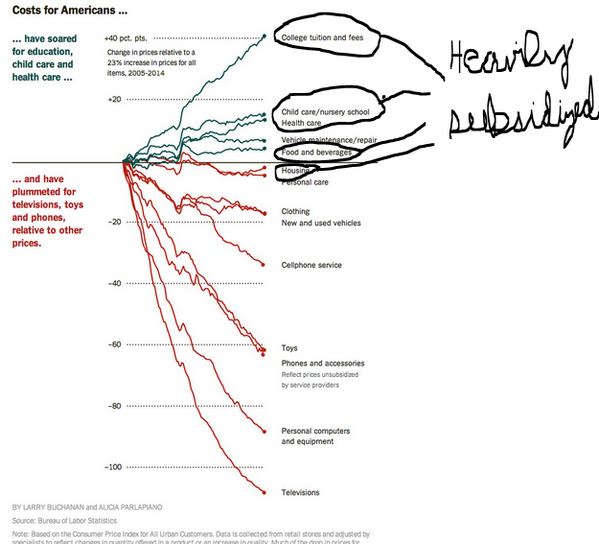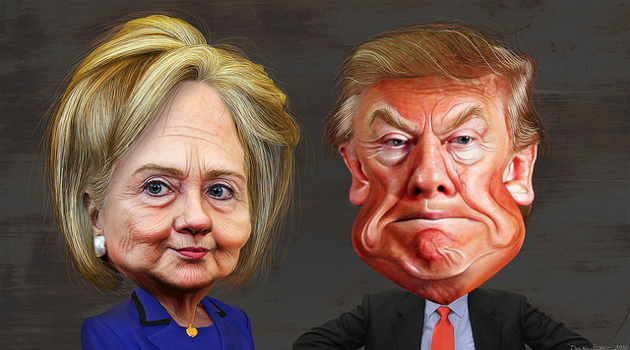When Donald Trump and Hillary Clinton agree on things, it’s always bad news for taxpayers.
 They both want to boost the capital gains tax rate on private equity investment.
They both want to boost the capital gains tax rate on private equity investment.- They both want to let the entitlement problem fester and worsen.
- They both want more federally financed pork-barrel spending on infrastructure.
Now they both agree that it’s somehow the federal government’s job to subsidize child care, though they’ve each concocted different ways of implementing this new form of redistribution.
The Wall Street Journal opines on this fiscally incontinent bidding war.
…both candidates [are] offering multiple subsidies for raising kids. This will end up raising prices and it won’t address the real reason parents feel squeezed: a decade of slow or no economic growth. Donald Trump on Tuesday proposed a tax deduction that would let families write off the average cost of child care for up to four children, among other ideas. Hillary Clinton has already promised to limit care expenses to 10% of income; raises for caretakers; universal pre-K; an increase in the $1,000 per child tax credit; a new program for student parents, and more.
Looking at the details, Trumps plan would exacerbate the EITC problem.
Here’s the dirty detail: Mr. Trump proposed an up to $1,200 child-care tax rebate for low-income families that would be delivered by expanding the earned-income tax credit. But the credit would inevitably phase out as income increases and disappears at $31,200. The result would be a higher inframarginal tax cliff—when people are discouraged from earning more income because they lose more in benefits than they can gain in wages. This disincentive to advancement is already steep.
He’s also proposing a new subsidy for savings accounts.
Mr. Trump also proposes savings accounts for child care to add to the tax-free destinations for retirement, health care, college and more. This new benefit, worth up to $2,000 a year, would make tax reform more difficult. The government would also match parental contributions at 50% up to $1,000 a year for low-income families. That’s a wonky way of unveiling a new $500 transfer payment.
And Trump even wants to engage in a no-win bidding war with Hillary Clinton to create a new European-style entitlement for paid maternity leave (even though, as a columnist for the New York Times even admitted, this type of scheme will backfire against women by making them less attractive to employers).
Then there’s six weeks of paid maternity leave that Mr. Trump says he would guarantee through unemployment insurance. He claims he’ll pay for this by cleaning out fraudulent payments, though this is his funding mechanism for every proposal. Mr. Trump will nonetheless lose the family bidding war with Mrs. Clinton, who wants 12 weeks of paid leave for new mothers and fathers.
The Clinton plan, meanwhile, is a predictably statist prescription for more intervention and subsidies.
 And the WSJ‘s editorial correctly points out that is a recipe for ever-higher costs.
And the WSJ‘s editorial correctly points out that is a recipe for ever-higher costs.
Mrs. Clinton raises the Trump offer in every regard, from more Head Start funding to salary support for day-care workers. And if you think care is expensive now, wait until Mrs. Clinton wades in. She likes to say that child care can be more expensive than college tuition, which is false. The irony is that her day-care blowout would recreate what has made college notoriously expensive—large subsidies for the provider and buyer. Day-care centers and pre-Ks could raise prices, confident that government will cover the increase.
The fact that Hillary Clinton wants bigger government is not the most shocking revelation in the world.
Her voting record as a Senator was almost identical to Bernie Sanders’.
And every single proposal in her big economic speech last month required a larger burden of government.
But it’s rather odd to find the Republican nominee being the statist Tweedledee to match the statist Tweedledum.
In an article for Commentary, Noah Rothman looks at Trump’s overall approach to fiscal policy.
Donald Trump…is a self-described Republican who has cast aside the austere facade of fiscal conservatism in favor of any and every spending proposal that crosses his transom. Promising the electorate the world in the campaign with every intention of working out the details after the election is hardly a new phenomenon, but it used to be one that Republicans rejected. Today, under Trump’s corrupting umbra, the GOP has become the party of wild assurances and cascading spending proposals with no intention of ever making good on them.
Actually, I fear the spending promises would be fulfilled if Trump got to the White House. Though I agree that Trump personally doesn’t care if they are either adopted or forgotten.
Here are just a few of the spending promises Trump has made.
Trump promised to augment the Pentagon’s budget by repealing the portions of the Budget Control Act of 2011 (aka, “Sequester”) that imposed limits on defense spending. …Trump has called for “more funding” for the Department of Veterans Affairs to augment job training, research on traumatic stress, brain injury, and suicide prevention, and to hire more service providers at VA hospitals. The Republican nominee promised a massive $500 billion public works program that you dare not call a “stimulus,” which he proudly boasted would spend more than double what Hillary Clinton has pledged to refurbish America’s infrastructure. …He has attacked as cold-hearted the idea that America’s entitlement state must be curtailed and reformed—a massive expenditure that already consumes nearly two-thirds of the nation’s annual outlays.
In other words, Trump is a big-government, Nixon-style Republican.
Which means advocates of limited government are not exactly thrilled about November.
P.S. Other Republican presidential candidates have boosted the burden of government when they took office (President George H.W. Bush and President George W. Bush are two dismal examples of this phenomenon). But they at least pretended to be vaguely in favor of smaller government during their respective campaigns. The fact that Trump doesn’t even fake it during the campaign suggests that economic policy would be very bad if he ever got to the White House.


